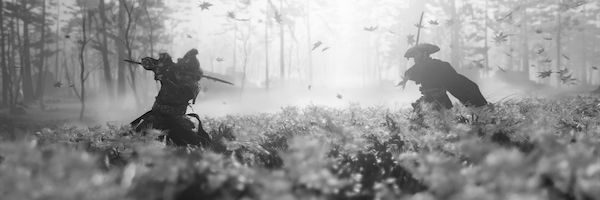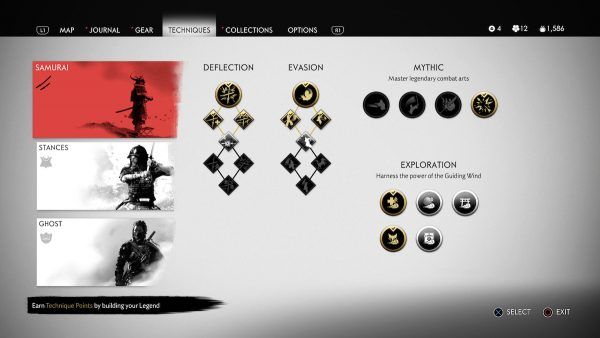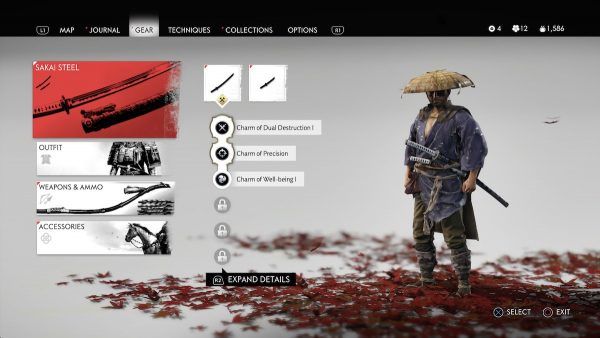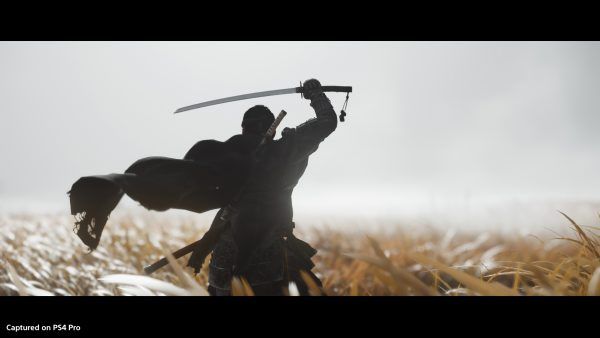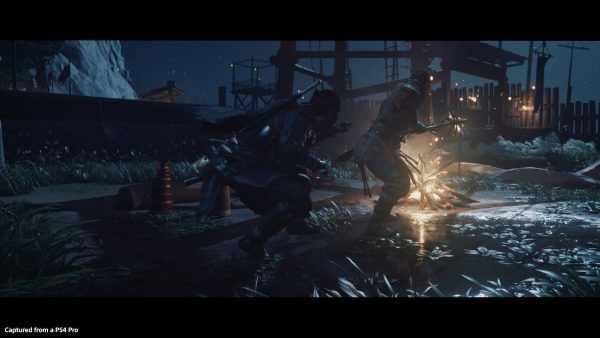[Editor’s Note: Some minor spoilers ahead for the upcoming video game Ghost of Tsushima, though we’ll keep this combat guide as spoiler-free as possible. Be sure to check out our review here and our Tips for Beginners, too.]
If you're gearing up to play Ghost of Tsushima, the new and highly anticipated release from Sucker Punch Productions for the PS4, you're going to want to brush up on your combat mechanics early and often. I broke down the various playstyles and approaches to the game's objectives in our tips guide linked above (including which load-outs to use and when), but here, I'll get into a little more detail when it comes to combat mechanics. And while this will certainly be an evolving article as more and more people get to experience the game, this should be more than sufficient enough to get you started. The rest is just practice and repetition.
A note: My experience comes from the first act of Ghost of Tsushima. The enemies do seem to level up with you in difficulty (mostly) as you progress, with some geographical limitations, ie easier enemies closer to where you start the story. Additionally, I'm playing on Easy mode, meaning the Mongols are undoubtedly going to hand your ass to you more often than me if you're not a tourist and are playing on Normal or Hard. Regardless, the mechanics are the same. (Feel free to challenge me to a duel when you're ready, preferably in a cinematic thunderstorm.)
Defense
"The best defense is a good offense." That age-old adage rings true for most combat sports, but in Ghost of Tsushima, it's probably going to get you killed. You can button-mash light and heavy attacks all day long, but even in Easy mode, you will get trounced on occasion. The combat system simply isn't set up that way. Instead, it's both a subtle game of Rock, Paper, Scissors and a test of skill to see how closely the player is paying attention. So before you even swing your sword, here's how to use it in defense:
Block, Parry, Dodge, Repeat. If you can get the timing of these defensive moves down, you're halfway to victory already. Blocks can turn aside general attacks while Parries can counter attacks with a blue glint; Perfect Parries offer a bonus to Staggering your opponent, but even a basic Parry can give you an opening. Dodges and Rolls, however, are for unblockable attacks, and there are a lot of them; if you see a red glint coming at you, dodge/roll out of the way. Every type of enemy has a different pattern of attack, different weapons and timing, different range, etc.; getting your defense down takes practice and patience, and a whole lot of fights. There are Charms, however, that can make your life easier in combat, not just by mitigating damage received or boosting how much damage you deal, but by actually making Parrying easier to achieve through a timing buff or "terrifying" nearby enemies after a perfect parry. (Visit those shrines!)
Even if your defense falters, be sure you have some Resolve in reserve; it'll let you heal up by punching yourself in the side, samurai-style, to get all amped up for the fight. To do some damage, however, we'll have to go on the offensive.
Offense
It should go without saying, but you'll want to unlock as many combos as you can ASAP, especially if you want to trade sword blows with Mongols for hours and hours of gameplay. These combos bring some versatility to your swordsmanship while also dealing bonus damage to your opponents, with the added benefit of just looking badass while doing it. So whether you're breaking an opponents defense with a series of devastating overhead blows, getting past their guard with an unexpected mule kick, or scaring the crap out of the competition with a Mythic strike, it pays to unlock those combos early and practice them often. (It's also good to practice your timing and attention to your opponents movements in the optional Stand-offs, which you can trigger or not, and the epic Duels, which are among the best moments in the game.)
But not every button-mashing combo is going to cut it (unless you're practicing on the Bamboo Strikes, which you should be). You'll need to remember certain combos for certain types of enemies: Swordsman, Shield-bearers, Spear-wielders, and Brutes, among others. A lot of these combos are similar, some almost identical, so it's not that hard to master. The real trick comes in remembering to make sure you're in the right Stance.
Stances
Remember that Rock, Paper, Scissors mention? Here it is! Both defense and offense can be unlocked by going through the Deflection and Evasion skill trees, but you'll need to progress through the story to unlock Stances. This will get a little spoilery because of that fact:
You start with Stone Stance, which is good against Swordsmen. Fun Fact: Swordsmen are exactly who you face early in the game, with a little variety thrown in. You can upgrade the Staggering heavy attacks and Piercing attacks, which gain speed down the tree. Next is Water Stance which uses flowing strikes to get around shield-bearers. These heavy strike combos are easy to master but brutal for your enemies on the receiving end. Then there's the Wind Stance, used against spearmen. This fun stance comes with a powerful back kick (occasionally right to the jaw) and an auto-parry if you progress its tree far enough. Finally (or maybe not...), there's the Moon Stance, which is used against brutes. These quick kicks and slashes will take down even the biggest of opponents. Once you've mastered those, who knows what else awaits you?
Ghost Weapons
So, you've strayed from the path of the honorable samurai and discovered the way of the thief and assassin. That's okay, I'm not judging you (though your uncle might). In fact, the tanto blade and a fantastic array of Ghost weapons are more often than not the necessary tools of the trade; they'll get the job done, or get you most of the way there, allowing you to mop up any extra combatants with your katana. Because of this, it's useful to get just as comfortable with your Ghost weapons as you are with your sword, and make sure to unlock their skill trees ASAP (but there are a bunch).
Aside from your tanto, which is used for sneaky assassinations (or multi-assassinations if you have the skill unlocked), Ghost weapons are mostly throwables: Kunai, smoke bombs, sticky bombs, black powder bombs, and even distraction-worthy wind chimes and firecrackers. These are the many and varied tools and weapons of the Ghost path. Sometimes a quest objective will encourage you to use them in certain ways, such as killing an enemy who's investigating a wind chime. Other times, they'll just be good to use in general, such as the kunai's ability to take out multiple enemies, stagger larger opponents, or even take down flying Mongol eagles. There's a lot of variety offered in how you approach each scenario here. But even though stealth and silent assassinations are useful, sometimes it's best to attack from a distance.
Archery
Shout-out to my fellow Sneaky Archers. Ghost of Tsushima has a pretty robust stealth/sneak mechanic (which may be OP, if we're being honest), but combined with a solid and straightforward archery option, well, it's hard to beat that. Throughout the game, you'll get access to the short half-bow and its quiver of both normal and fire arrows, as well as the rangy longbow and its complement of hard arrows and explosive arrows. No real zooms or scopes here (it's the 13th century, after all) but the Concentration trigger slows time down for you to make precision headshots. There are even Charms that offer bonuses for archery-related stats, such as nocking and reload speed, damage boosts, and even a few perks that have a chance of kicking back a used arrow or restoring some Resolve.
Charms are a great overall way to fine tune whatever load-out you have. Even after you've mastered the combat combos, feel confident switching between Stances, and can flow from offense to defense, Samurai to Ghost, with ease, these Charms will add all kinds of stat bonuses to your gear. Some are great for combat, while others are better for stealth, archery, or even exploring. Sucker Punch has provided a ton of flexibility and unique options to your build here. So while Jin Sakai's story may play out pretty much the same way no matter who is playing it, these options (and the fantastic variety of cosmetics) will let every player do it in their own signature style.
Got any other combat questions or tips? Be sure to let us know!
Dave Trumbore is Collider's Senior Editor overseeing Games, Animation, and all those weird Saturday-morning cartoons no one else remembers. Test his trivia IQ on Twitter @DrClawMD

